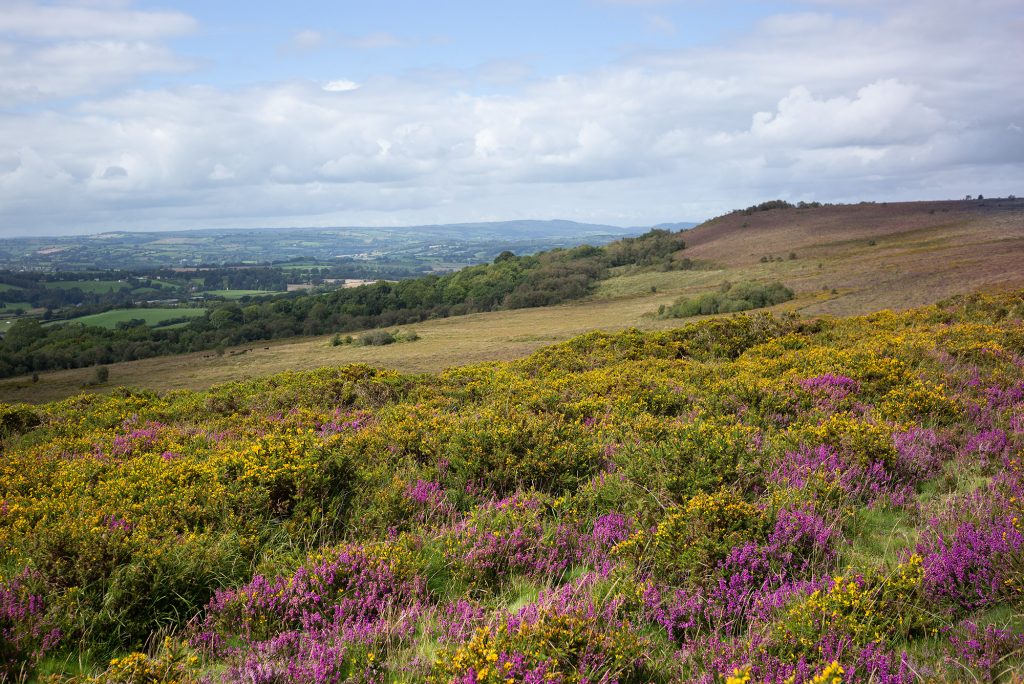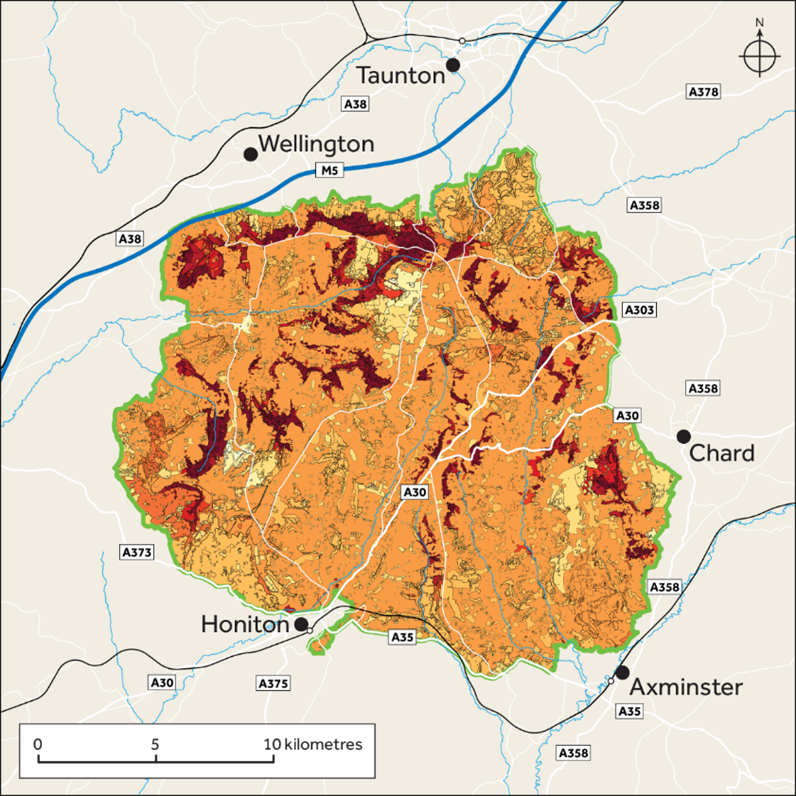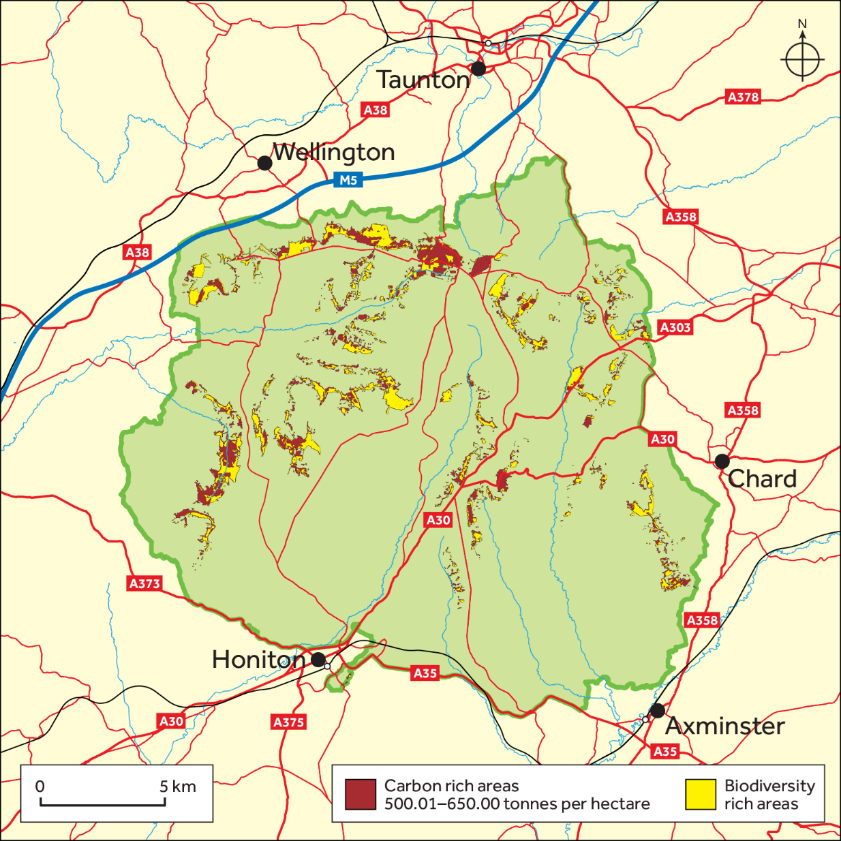Chapter 7: Climate

Blackdown Hills National Landscape Management Plan 2025-2030
Chapter 7: Climate
Coping with climate change is likely to be one of the greatest challenges of the 21st century as global warming makes its impact. The latest climate change projections for the South West indicate there are likely to be warmer wetter winters, hotter summers, more extreme weather events such as heat waves, torrential downpours of rain, extreme wind and storm events and rising sea levels.
These changes in climate are likely to create significant impacts which will affect all aspects of the south-west’s economy, society, infrastructure and the natural environment. As such, climate is very much a cross-cutting theme throughout this plan, however this part provides a focus for key objectives and principles.
In this chapter:

7.1 Objectives – Climate
- To safeguard the carbon stores in the Blackdown Hills National Landscape, reduce emissions from land and increase carbon sequestration, in ways which are compatible with nature.
- To promote and deliver nature-based solutions to climate change.
- To play an active role in addressing the climate emergency by delivering meaningful actions for climate change mitigation and adaptation, ensuring the actions are aligned with existing national, regional and local plans.
7.2 Guiding principles – Climate
- The climate and nature crises are intrinsically linked.
- We need to work urgently to mitigate climate change, including storing a much more carbon in our landscape, especially in soils and trees.
- We need to ensure that climate change mitigation and the pathway to net zero is appropriate to the character of the Blackdown Hills, is consistent with the purposes of the National Landscape designation and protects the landscape’s special qualities.
- Fossil fuels must be phased out as an energy source, and energy consumption must be minimised wherever possible.
- We need to take measures to help our communities adapt to climate change.
- The climate change transition process must be democratic, fair and involve all communities, ensuring that no communities are unduly affected.
- We need to move beyond growth being the only measure of economic progress.
7.3 Targets – Climate
We will contribute to the following targets set out in the Protected Landscapes Targets and Outcomes Framework (PLTOF):
Target 6
“Reduce net greenhouse gas emissions in Protected Landscapes to net zero by 2050 relative to 1990 levels”.
Target 7
“Restore approximately 130,000 hectares of peat in Protected Landscapes by 2050”.
The national target is to restore 130,000 hectares of peat in Protected Landscapes by 2050. There is no deep peat in the Blackdown Hills National Landscape (as defined by Defra) and therefore we will not be directly contributing to the national target. However, we can still play an important part in peat restoration and carbon capture given that “soils with peaty pockets (scattered pockets)” cover an area of 10,017 hectares (24,752.5 acres) which is 27% of the Blackdown Hills National Landscape.
Note that Target 8 “Increase tree canopy and woodland cover (combined) by 3% of total land area in Protected Landscapes by 2050 (from 2022 baseline)” is included as a target for mitigating and adapting to climate change in PLTOF. However, we have included it in the Place theme as trees, woodland and hedgerows are an essential element of the character of the Blackdown Hills landscape, providing many ecosystem services.
7.4 At a glance – Climate
Headlines from the State of the Blackdown Hills National Landscape Report 2023
- A 10% reduction in total greenhouse gas emissions across the local authority areas between 2017 and 2021.
- Three operating renewable energy generation sites in the Blackdown Hills National Landscape.
- A 5% increase in carbon accumulating in the soils and vegetation between 2017 and 2021.
- 9-millimetre increase in annual rainfall and a rise of 0.3oC in annual temperature over the last 30 years (this masks the increasing occurrence of extreme events).
Additional data from Department for Energy Security and Net Zero 2024: Greenhouse gas emissions data
See appendices for full data. The greenhouse gases covered by these statistics are carbon dioxide, methane and nitrous oxide.
Between 2005 and 2022, the estimated total greenhouse gas emissions in the Blackdown Hills National Landscape saw a decrease from 276.4 to 204.8 ktCO2e. The figures are shown in ‘kilo tonnes of carbon dioxide equivalent’ – ktCO2e. Levels dropped for the following sectors:
- Industry: 5.2 to 3.0 ktCO2e.
- Commercial: 7.3 to 2.7 ktCO2e
- Public sector: 0.9 to 0.3 ktCO2e.
- Domestic: 41 to 19.7 ktCO2e.
- Agriculture: 199.8 to 166.6 ktCO2e.
- Waste: 11.2 to 3.9 ktCO2e.
- The estimated total greenhouse gas emissions for Transport increased over the same time period from 57.3 to 58.3 ktCO2e.
- Land Use, Land-Use Change and Forestry (LULUCF) activities are both a source and sink for carbon dioxide and a source of methane and nitrous oxide. Generally, emissions are produced from conversion of land to cropland and settlements and are removed through forest growth and conversion of cropland to grassland. Emissions to the atmosphere are given as positive values; the removals from the atmosphere are given as negative values. LULUCF activities in the Blackdown Hills have consistently been a sink between 2005 and 2022, with a figure between -46.3 and -50.6 ktCO2e per annum.
During the same period:
- Per capita emissions dropped from 21.70 to 14.40 tCO2e (tonnes of carbon dioxide equivalent).
- Emissions per km2 dropped from 0.7 to 0.6 tCO2e.
7.5 Priorities for action – Climate
Actions to address the climate emergency are cross cutting, and it is imperative that they should be an integral aspect of all plans, projects and programmes operating across the Blackdown Hills.
Actions for climate change mitigation
Produce a comprehensive pathway to net zero for the Blackdown Hills National Landscape following these steps agreed among the National Landscapes family:
- Using the greenhouse gas emission data from government (and other data sources) to identify key areas of emissions, such as industry, commercial, public sector, domestic, transport, waste management, agriculture, and Land Use, Land-Use Change, and Forestry (LULUCF).
- Identify the areas in which the Blackdown Hills National Landscape partnership and its key partners can directly influence progress towards net zero, and collaborate with local authorities, businesses, and other relevant stakeholders to address emissions beyond the partnership’s jurisdiction.
- Quantify the depth and date range of the remaining peat deposits and the total carbon contained with in them.
- Prioritise areas for immediate impact and plan how to engage stakeholders to reduce emissions or promote land use changes for carbon sequestration.
- Coordinate with existing plans and integrate climate action plans with nature recovery strategies to create a cohesive approach to climate action.
- Evaluate the feasibility and interdependencies of different actions and identify potential barriers to implementation.
- Develop planned actions for the short, medium, and long term to meet Net Zero targets.
Carrying out a carbon assessment of emissions will create a carbon footprint for the Blackdown Hills National Landscape. This alone will not produce a pathway to net zero, but it will allow us to understand the key areas of emissions and begin targeting areas for emissions reduction, whilst quantifying the amount of carbon sequestration required to meet net zero.
Actions for Climate Change Adaptation
Produce a climate change adaptation management plan for the Blackdown Hills National Landscape, linked with this management plan by 2028, and all future plans. See appendices for further information.
Refine the climate adaptation risk assessment matrix already drafted, which identifies the climate risks in the Blackdown Hills National Landscape and use the information to develop the required climate adaptation plan for the area, for example:
- In the natural environment, risks identified include reduced and changed biodiversity – loss of trees, loss of pollinators, loss of water, flooding, loss of soil.
- Actions to address this include mainstreaming soil health and regenerative farming and forestry techniques, in order to build resilience of soils, that will in turn help with infiltration of water and storage of carbon, and well-connected habitats which allow species to move to new climate spaces (e.g. different aspects, slopes, feeding and breeding opportunities, shade/ sun) and avoid local extinctions.
- For Built Environment, Community and Economy, risk includes increased flooding and pressure on infrastructure, especially medical. Pressure on sewerage and loss of drinking water.
- Actions to address this include nature based solutions that build resilience for communities and critical infrastructure, as well as provide a range of co-benefits including for biodiversity, carbon and water quality – for example by reducing flooding in the built environment, providing ‘natural sponges’ to store and slowly release water in times of drought, and providing ‘natural filters’ to help improve water quality. Also, tree and shrub canopies which provide shade and significant cooling benefits for communities and much more tree planting to field boundaries as well as single trees in fields gives protection to livestock and wildlife alike.
- Actively consider areas where renewable energy installations maybe considered appropriate, where impacts can be minimised and more easily mitigated. Take care in relation to anaerobic digestor (AD) plants, which may distort cropping patterns in an area dominated by permanent grassland, which could lead to ploughing up of grassland and the planting of crops such as maize.
- Work collaboratively to address the risks and actions identified in the Blackdown Hills National Landscape climate change adaptation plan, seeking to highlight where actions from Devon, Cornwall and Isles of Scilly Adaptation Plan and Somerset Climate Emergency Strategy to build resilience and allow communities and the natural world to adapt, can be most effective.
7.6 Policies – Climate
For completeness, this set of policies should also be cross-referenced to the other thematic sections of this plan.
Education and behaviour change
C1 To transition to net zero, support communities, businesses and individuals to collectively make changes to their behaviour, such as energy use, eating habits, travel choices, waste disposal and climate adaptation planning more, in addition to using technological solutions.
Energy supply
C2 Use less energy to reduce the amount of new energy infrastructure required to meet net zero.
C3 Transition to renewables; energy used within the area needs to rise to near 100% renewable by 2050. The transition to low carbon and renewable energy should be undertaken in a way that seeks to further the conservation and enhancement of the natural beauty of the Blackdown Hills National Landscape, and is compatible with its special qualities, landscape character and heritage value.
Land and food: Nature based solutions
C4 Reduce Greenhouse Gas (GHG) emissions through encouraging sustainable farming practices and maximise carbon storage in the environment by encouraging interventions such as tree planting and peaty soil restoration.
C5 Develop demand for sustainably produced food.
Develop a resilient local economy and use of resources
C6 Avoid waste and create a circular economy through redesigning products to reduce their environmental impacts and improve their reusability and recyclability, buying second hand and recycling.
C7 Reduce emissions from unavoidable biodegradable waste and wastewater treatment.
Built environment: buildings retrofit and energy efficiency
C8 Develop and encourage measures which reduce energy usage in existing buildings and improve energy efficiency for all buildings using low carbon technology in all refurbishment, regeneration and improvement schemes. As part of the transition, new buildings need to be net zero as soon as possible.
Sustainable transport
C9 Reduce the need to travel and support the development of sustainable low carbon transport and active travel options, while working to avoid leaving any community isolated.
7.7 Context – Climate
7.7.1 Responding to climate change
Our planet’s climate is changing and warming at an accelerating rate. Recent years have seen the UK’s hottest ever recorded temperatures and the warmest winter temperature. The increased levels of greenhouse gases (GHG) from human activities mean we are trapping more heat and causing our planet to warm at an unprecedented rate. The science is clear: we are in a climate emergency and need to act now to reduce carbon emissions to limit global temperature rise to below 1.5°C.
Climate change is, in part, driven by human land use. In turn, a changing climate is exacerbating loss of biodiversity across the Blackdown Hills as elsewhere. However, actions that help reverse biodiversity loss will also contribute to increasing carbon sequestration and help make the landscape more resilient to climate instability. Nature-based solutions have a significant role to play in tackling climate change in the Blackdown Hills, for example by reducing flood risk in the river catchments while also improving conditions and habitats for wildlife.
Meanwhile regenerative approaches to farmland management improve the resilience of soils and crops to climate extremes. Some habitats in the Blackdown Hills, like mires, heaths and woodlands, already have high carbon stocks. Therefore, carbon content should be borne in mind when prioritising habitat creation or restoration, and trade-offs between habitats need to take account of carbon implications. Restoring habitats like springline mire and wetland and creating new woodlands in the right locations across the Blackdown Hills, will increase carbon sequestration as well as helping wildlife. And across the whole Blackdown Hills farmed landscape, modest changes in land management practices could have a large cumulative effect on carbon storage.
There is a role for everyone working in the Blackdown Hills to promote and implement lower carbon lifestyles, through organisations’ own activities to minimise their carbon footprint, for example by promoting local food, choosing venues accessible by public transport, and holding online meetings.
Moving away from the fossil-fuel-based economy is essential for the whole of society, though it is harder in some respects to make that transition in a rural landscape like the Blackdown Hills.
We need to do whatever we can to make it easier for businesses and residents in the Blackdown Hills to reduce their dependency on fossil fuels, for example through renewable energy, reduced energy use, and more opportunities to share transport. Our collective response to the climate crisis is unlikely to succeed if we expect to simply switch to renewable sources while maintaining current demand. We need to encourage a less profligate approach to energy use, seeking greater efficiency and reducing waste.
There is a massive societal shift required to respond to the climate crisis. That transition must be fair and equitable with the burden shared appropriately by all of us, according to our abilities and means. We must not allow the climate crisis to create new kinds of inequality. Given the need for all parts of our communities to be part of the change and given that climate change – and the transition to avoid it – affects us all, the decision making to enable change must include everyone. We need to recognise, as local communities and as a wider society, that our climate emergency is deepened by our continuing focus on economic growth as a measure of societal progress. A shift towards more progressive measures of a sustainable and circular economy, based less on resource depletion and more on regenerative principles, would make the fight against climate change more winnable.
Some climate change mitigation and adaptation measures have the potential to adversely affect the natural beauty of the National Landscape, but with careful design and implementation, many of these measures can not only conserve but also enhance natural beauty. The challenge is to develop a pathway to net zero which also conserves and enhances natural beauty. Notably, large-scale renewable energy developments can have a negative impact on landscape and scenic beauty, presenting potential conflicts between the need to tackle climate change and the statutory purposes of the National Landscape. Small-scale individual or community-based renewable energy schemes may be suitable provided there is no significant detrimental effect on the environment. A useful resource to inform consideration of the impact of renewable energy developments is Devon Landscape Policy Group Advice Note 2. Accommodating wind and solar pv developments in Devon’s landscape (2025), which covers the whole of the Blackdown Hills National Landscape.
7.7.2 Climate change mitigation
Climate change mitigation involves actions to reduce or prevent greenhouse gas emissions from human activities.
Mitigation efforts include transitioning to renewable energy sources, enhancing energy efficiency, adopting regenerative agricultural practices and protecting and restoring forests and critical ecosystems that act as carbon sinks.
If we can slow down the rise in greenhouse gases, we can slow down the pace of climate change and avoid its worst consequences.
Globally, nationally, and locally, reducing greenhouse gases can be achieved by:
- Shifting away from fossil fuels: Fossil fuels are the biggest source of greenhouse gases, so transitioning to modern renewable energy sources like solar, wind and geothermal power, and advancing sustainable modes of transportation, is crucial.
- Improving energy efficiency: Using less energy overall – in buildings, industries, public and private spaces, energy generation and transmission, and transportation – helps reduce emissions. This can be achieved by using thermal comfort standards, better insulation and energy efficient appliances, and by improving building design, energy transmission systems and vehicles.
- Changing agricultural practices: Certain farming methods release significant quantities of methane and nitrous oxide, which are potent greenhouse gases. Regenerative agricultural practices – including enhancing soil health, reducing livestock-related emissions, direct seeding techniques and using cover crops – support mitigation, improve resilience and decrease the cost burden on farmers.
- The sustainable management and conservation of forests: Forests act as carbon sinks, absorbing carbon dioxide and reducing the overall concentration of greenhouse gases in the atmosphere. Measures to reduce deforestation and forest degradation are key for climate mitigation and generate multiple additional benefits such as biodiversity conservation and improved water cycles.
- Restoring and conserving critical ecosystems: In addition to forests, ecosystems such as wetlands, peatlands, and grasslands also contribute significantly to carbon sequestration, while supporting biodiversity and enhancing climate resilience.
- Creating a supportive environment: Investments, policies and regulations that encourage emission reductions, such as incentives, carbon pricing and limits on emissions from key sectors are crucial to driving climate change mitigation.
7.7.3 Climate change adaptation
Warmer wetter winters, increased severity of storms, and hotter, drier summers are symptoms of a changing climate. These impacts are already being felt and will increasingly affect the special qualities and ecosystem services of our landscape.
Climate change adaptation refers to actions taken to adjust to a warming world and reduce the risks associated with it. National Landscapes can play a vital role in adapting to climate change and building resilient landscapes for future generations.
Climate adaptation reporting provides an opportunity to identify relevant climate risks, incorporate them into management processes, and encourage early engagement with stakeholders to address climate challenges.
Climate change adaptation management plans
The Government’s 2023 Climate Adaptation Strategy under the Third National Adaptation Programme (NAP3) requires all Protected Landscapes to produce climate change adaptation management plans, embedded in or linked with their management plans by 2028, and in all future plans.
National Landscapes climate adaptation risk assessments
A template has been created with the National Landscapes family, to provide a common approach for conducting climate adaptation risk assessments. While this approach will not directly produce a climate adaptation plan, it will identify the climate risks in each National Landscape and provide the information needed to create such a plan by 2028.
This risk assessment processes seeks to provide a general format to identify risks to key assets and features of each National Landscape, identify policy responses and relevant local stakeholders, and set out planned actions for the short, medium and long term. The template provides the flexibility for the risk assessment process to be carried out according to the needs of each individual National Landscape.
To produce a climate adaptation plan, National Landscapes can utilise the risk assessment process following these principles:
- Identify the key assets and features of the landscape.
- Assess the vulnerability of these assets and features to the impacts of climate change.
- Consider sectoral impacts for principal land uses such as farming and forestry, as well as the natural, built and historic environment.
- Assess the impacts based upon current climate change projections.
- Score these risks and opportunities based on their likelihood, impact and risk, over the short, medium and long term.
7.7.4 Carbon stores and stocks
Protected Landscapes contain some of the UK’s most important carbon stores, including significant tracts of peatland, woodland and hedgerows providing important carbon sinks for achieving net zero.
In 2022, the National Association of Areas of Outstanding Natural Beauty (now the National Landscapes Association) commissioned Cranfield University to undertake a carbon audit and metric (land management) assessment. [Zawadzka, J.E., Keay, C., Hannam, J., Burgess, P.J, Corstanje, R. (2022). National Landscapes Carbon Audit and Metric (land management), Bedfordshire: Cranfield University.]
The overarching goal of the project was to provide a baseline assessment of organic carbon storage capacity of and fluxes from habitats (that is the overall capacity of a habitat to remove or release carbon from or to the atmosphere) present within all 34 National Landscapes in England, with an emphasis on priority habitats. The carbon audit focussed on carbon stocks and stores in the soils and biomass of priority and non-priority habitats within the National Landscapes. Along with a few additional sources, the audit was based on two main data sources:
- The NATMAP (the National Soil Map of England and Wales) carbon dataset which maps soil carbon stocks (at 1:250,000 scale).
- Available literature summarised within the 2021 Natural England Research Report 094) titled Carbon Storage and Sequestration by Habitat: A Review of the Evidence (NERR094).
It found that soil carbon stocks, (expressed as tonnes of carbon per hectare), were generally higher in priority habitats than non-priority habitats. However, the absolute amounts of carbon stored within habitats, (expressed as tonnes per habitat area), was higher in non-priority habitats, which can be explained by their large geographic extent.
This assessment highlighted that both priority and non-priority habitats within the National Landscapes are valuable carbon stores with a good potential for carbon sequestration (especially associated with woodland).
Therefore, the main recommendation from this research is to preserve current high levels of carbon storage where they exist as well as to increase the level of soil and biomass carbon on non-peaty soils, with a caveat that any land cover conversions should be preceded with thorough impact assessments on biodiversity, other ecosystem services, livelihoods, and net emissions of greenhouse gases.
Fieldwork was also undertaken as part of the carbon audit, comparing soil organic carbon contents represented by the NATMAP carbon dataset to soil samples dug within three different National Landscapes: Blackdown Hills, Shropshire Hills and High Weald. This showed that when local samples of soil carbon taken from fields were compared against the national NATMAP data there was a strong correlation, which therefore gives us confidence in the NATMAP data and using it for decision making, such as where to focus land management advisory effort. Further detail is included in the appendices.
Outputs for the Blackdown Hills:
Total soil carbon stored (0-150cm depth of soil, medium value): 7,740,695 tonnes/ carbon– based on NATMAP data
Of this, the amount stored in non-priority habitats is 6,257,900 tonnes/ carbon and the amount stored in priority habitats is 1,482,795 tonnes/ carbon
Based on literature, biomass carbon (stored above ground in vegetation) = 851,731 tonnes/ carbon (medium estimate for t/ C)
Based on literature, carbon flux = 571.10 loss of CO2e [CO2e gains (-)/losses (+) per habitat area]
Based on literature, an alternative carbon flux metric= 164.90 loss of carbon [C gains (-)/losses (+) per habitat area]
The following maps illustrate potential ‘win-win’ land management scenarios, where there are high densities of carbon stocks (dark brown colour on Map 1) and also a concentration of priority habitats (shown as yellow biodiversity rich areas on Map 2). In other words, areas of high-density soil carbon in the Blackdown Hills strongly coincide with the areas of high biodiversity importance. Therefore prioritising these areas for restoration of habitats will also make a positive contribution to locking up carbon in soils.


A further follow-on piece of work, building on the Cranfield carbon audit and metric study was undertaken in the Blackdown Hills to explore how this may be used to inform land management decisions, [Soil Organic Carbon in the Blackdown Hills National Landscape: Towards a Framework for Guiding Land Management Decision Making Report of a study undertaken in winter 2022-2023 in the Blackdown Hills Area of Outstanding Natural Beauty. Fred Constantine Smith with support from Gavin Saunders, Richard Smith and Tim Harrod, May 2023]. Further information can be found in Appendix 3.
Report headlines:
- Different soil types vary greatly in their carbon stores, and their potential to hold more carbon.
- Soil carbon storage can be increased both through productive, in-field practices, and habitat creation or management.
- Managing productive soils to store more carbon also improves soil health.
- Managing wildlife habitats and creating new habitat also increases soil carbon storage.
- Each soil type can be managed to maximise its ability to store carbon, and the opportunities for doing so vary between soil types.
- Vegetation with high nature conservation value generally has the highest level of soil organic carbon (SOC), with wet woodland, mire, and wet heath having the highest of all.
- The peaty and organic ‘Blackdown’ and ‘Hense’ soil types store the most carbon per hectare.
- Medium brown soils with a large area in the landscape, such as the ‘Whimple’ and ‘Batcombe’ soil types, can play a significant role in carbon sequestration via good soil management practices.
- A focus on soil carbon can offer a triple-win, for carbon sequestration, soil health, and biodiversity.
- Humic soils (e.g. Hense) – found on the springline. These naturally wet soils have high carbon levels when carrying semi-natural vegetation. Where they have been drained and agriculturally improved, rewetting them and restoring semi-natural vegetation could yield significant carbon gains.
- Brown Earths (e.g. the Batcombe) – found on the plateau. These have a lower capacity for holding carbon (compared with wetter soils), but their extent means that the raising their soil carbon by just a small amount would have a significant impact on total carbon stocks in the landscape.
Offering much potential to help mitigate climate change, these existing carbon stores need to be protected and restored to maximise carbon sequestration. Restoring characteristic habitats like springline mire and wetland, managing woodland and creating new woodlands in the right locations across the Blackdown Hills, will increase carbon sequestration as well as helping wildlife. And across the whole Blackdown Hills farmed landscape, modest changes in land management practices could have a large cumulative effect on carbon storage.




